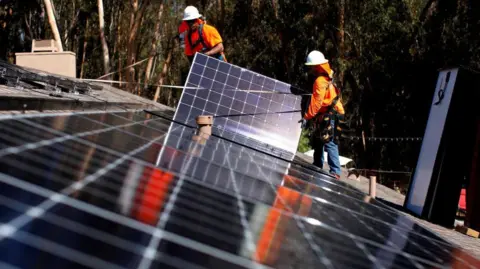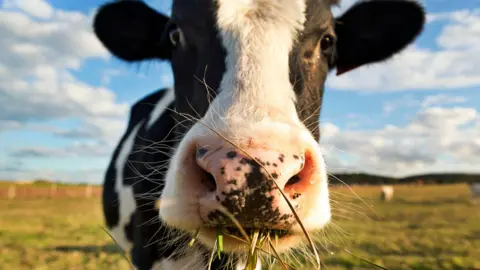NI on track to reduce greenhouse gas emissions by 2032
 Reuters
ReutersNorthern Ireland is on track to significantly reduce its greenhouse gas (GHG) emissions, with a new report forecasting a 33% decrease by 2032.
The change has mostly been driven by a move away from coal in the energy sector.
But it falls well short of the “at least 48%” reduction required by the Climate Change Act 2022.
The figures are based on the latest data from the Northern Ireland Greenhouse Gas Inventory (1990-2021).
Emissions in 2021 stood at 22 million tonnes of carbon dioxide equivalent (MtCO2e), a 23% reduction from the 29 MtCO2e emitted in 1990, the base year.
Shift from coal-fired to gas and renewable energy
 Getty Images
Getty ImagesThe report, published by the Department of Agriculture, Environment and Rural Affairs (DAERA), projects that emissions will further decrease to 20 MtCO2e by 2032.
This represents a 13% reduction from current levels as Northern Ireland continues its push towards a more sustainable future.
A key driver of the decline is the shift from coal-fired to gas and renewable energy in the energy supply sector.
By 2032, energy-related emissions are expected to decrease by 49%, contributing significantly to the overall reduction.
However, not all sectors are seeing such progress.
Emissions from agriculture, Northern Ireland’s largest sector, are projected to decline by only 1%, leaving it responsible for an even larger share of overall emissions.
 Getty Images
Getty ImagesMeanwhile, transport emissions are expected to fall by just 7%, despite the rise of electric vehicles and biofuel use.
The report also highlights the Northern Ireland Climate Change Act, which commits the region to achieving net-zero emissions by 2050.
Interim targets have been set, including a 48% reduction in emissions by 2030, though experts caution that additional policies will be needed to meet these goals.
On Friday, Northern Ireland’s first Environmental Improvement Plan (EIP) was approved by the Northern Ireland Executive.
